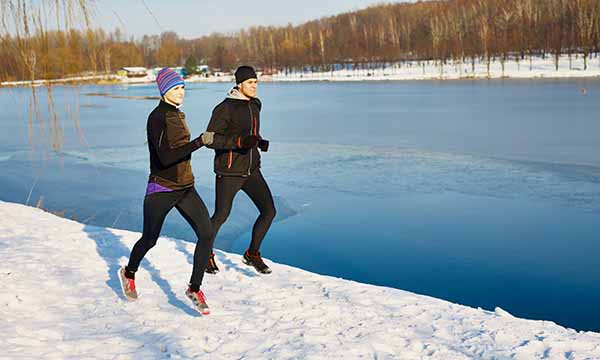6 Winter Running Tips (Make Running in the Winter Bearable)
Freezing temperatures make running miserable. Just the thought of waking up early morning and running outside can make one shiver. In the winter, it can be hard to motivate ourselves to go running every day.
If you’re a runner and can relate, you know there’s no turning back. Even though you really just want to hide under your comfortable blanket, skipping a running session will make you feel guilty and throw off your entire routine.
How do you make running more bearable in the winter? There are still ways to improve your skill and strength when Mother Nature doesn’t cooperate. Here are some tips for a new runner planning on running through the winter for the first time.
1. Keep Your Phone Close to Your Body to Keep It Warm
When running, having your phone with you is a smart move for your safety and security. You may also track your distance or listen to music to help you power through your workout.
But if your phone gets cold, the battery might drop close to zero in seconds before turning off completely. Once the battery warms up again, the phone shows enough power to turn back on.
So how to keep your phone warm while running?
If you keep your phone in the outer pocket of your running jacket, or in an armband, the battery will freeze and the phone will shut down when it gets cold.
Quick tip to prevent your phone from shutting off during cold runs: Put an elastic running belt, like FlipBelt Zipper, against your body and under your shirt and jacket, and slip your phone in there. This keeps it warm during the run and makes it usable in the event of an emergency.
Since our next-to-skin clothing layer rarely has pockets, the elastic running waist belt is the most practical option to keep your phone warm. It also helps if you are carrying a water bottle. It keeps the nozzle of the water bottle from icing over.
Beware of sweating, though. As not all elastic running belts can withstand moisture, it may be wise to put your cell phone first in a ziplock plastic bag.
2. Wear the Right Winter Shoes
Keep your feet warm and the snow out by wearing running shoes without a lot of mesh. Look for running shoes with Gore-tex uppers, as they are great for winter running. Wear socks that keep your feet warm and wick away from the wetness.
Shoes with enough traction to handle slippery patches of ice are an essential part of safe winter running.
3. Dress for the Summer
For me, the biggest problem with winter running has always been the proper dress. Either I freeze my hands or my legs get stiff, or I sweat too much.
When the weather outside is chilly, we have trouble keeping our muscles warm, which can lead to injury. Cold increases stiffness, which makes muscles less responsive and flexible, and therefore more exposed to trauma.
So you need to stay warm, but you do not want to sweat so excessively that it leads to you getting a chill.
Add 10 to 20 degrees to the current temperature when wearing your running clothes. When you start to run, you want to feel a little cold. Wear layers of material to wick away the sweat with zippers at the underarm and neck to vent air as your body heats up.
A good pair of athletic pants that will wick away your sweat while keeping your legs warm is crucial for winter running.
It took me a few tries and mistakes before I found the right clothes for myself. So prepare for some trials and errors, and plan on adopting some new running gear that will help you shield against the pitfalls of cold weather. The more you run in different conditions, the better you know what to wear.
4. Ensure Others Can See You
Morning runs in the winter mean limited daylight. Making it even harder to run are the tall mounds of snow on freshly plowed streets.
Wear reflective and fluorescent gear, so others can see you. You should also ensure you can see the path ahead of you clearly by wearing a headlamp or using a flashlight.
5. Trick the Wind
If it’s windy outside, run into the wind at the start and end it at your back. Doing so will prevent the wind from blasting you after you’ve started sweating.
Run into the wind for around 10 minutes and then turn to run with the wind for five minutes at your back. Repeat.
Other helpful tips include applying Vaseline to your face or wearing a face mask prior to running.
6. Motivate Yourself with a Reward
Lure yourself outside by treating yourself at the end of the run. Your reward can be catching up with a friend or eating a delicious sweet treat.
You can even partner up with someone. If you both have frustrations with running in the winter, you can share them and show up the next day to work it out. When it comes to eating something sweet, we recommend you eat a healthy treat.

When to Stay Inside?
When there is too much snow and ice on the ground, it might be time to hit the gym. Running on a treadmill can help you build up your strength and endurance without the risk of injuries that slippery conditions can bring.
Running on a treadmill is gentler on your knees, so it’s not a bad idea to alternate between outdoor and treadmill running. By knowing when it is a smart idea to stay inside, you will make sure you avoid weather-related injuries.
Conclusion
Winter running is not difficult once you get into the routine of doing it. Winter running will be tough at first, but it will get easier. Just don’t give up. For some motivation, check out other articles on OutdoorFitLab.




